Grade 4 Adding and subtracting unlike fractions: Free download
Do your students need help understanding how to add and subtract fractions when the denominators are different? If yes, then find your solution here. This article will provide Grade 4 worksheets focusing on adding and subtracting unlike fractions. You can download these worksheets and print them as often as possible.
-
In this article, we aim to help your 4th graders learn how to add and subtract fractions with different denominators and understand the importance of finding the LCD to succeed.
From confusion to confidence: How Grade 4 adding and subtracting fractions with unlike denominators worksheets can help
Mathematics can be a daunting subject, especially when it comes to fractions. For many students, the mere sight of fractions on a page can induce confusion and anxiety. To uplift these students from confusion to confidence in solving all fractions problems, we will provide remarkable Grade 4 worksheets to guide them through the process of adding and subtracting unlike fractions, step by step. This article aims to help us see how Grade 4 adding and subtracting fractions with unlike denominators worksheets can help 4th graders in mastering this important math concept.
Also, it is interesting to note that these worksheets will provide students with ample practice opportunities, allowing them to master this essential skill and build their confidence in the process. This article will explore the benefits of grade 4 adding and subtracting unlike fractions worksheets, and how they can help students become math experts.
-
BROWSE THE WEBSITE
-
DOWNLOAD FREE WORKSHEETS
-
-
4th GRADE MATH TOPICS
- Number sense
- Addition
- Subtraction
- Multiplication
- Division
- Mixed operations
- Variable expressions
- Functions
- Coordinate plane
- Data and graphs
- Logical reasoning
- Patterns and sequences
- Money math
- Units measurement
- Telling time
- Equivalent fractions
- Compare & order fractions
- Add & subtract fractions with like denominators
- Add & subtract fractions with unlike denominators
- Multiply fractions
- Decimals
- Add and subtract decimals
- Probabilities and statistics
- 2D shapes
- Triangles and quadrilaterals
- Symmetry
- Angles
- 3D shapes
- Geometric measurement
-
-
Identifying fractions with a particular sum denominators
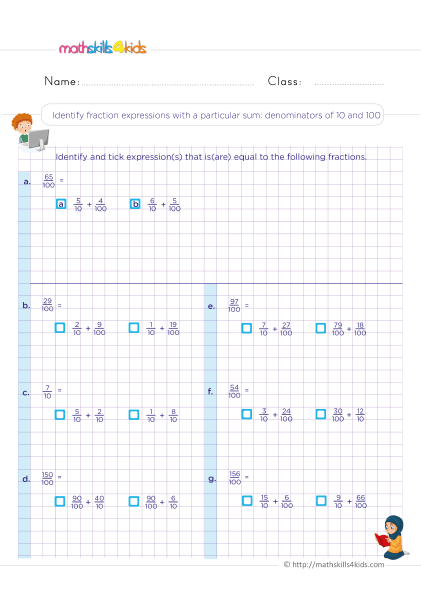 Print it...
Print it...
-
Add and subtract fractions unlike denominators word problems
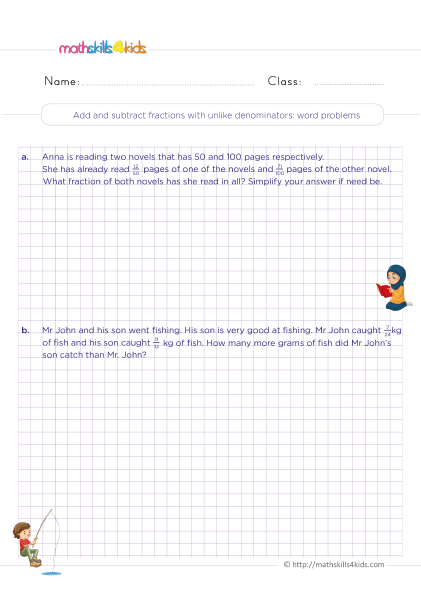 Print it...
Print it...
-
How do you compare sums of unit fractions
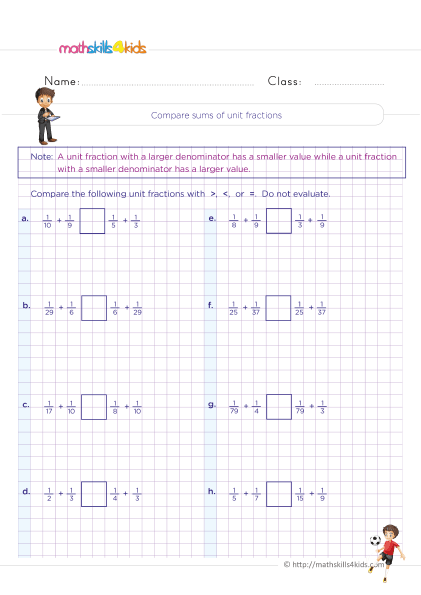 Print it...
Print it...
-
Comparing differences and sums of unit fractions
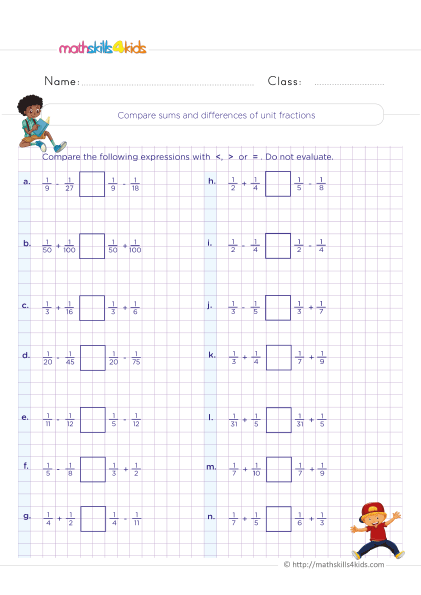 Print it...
Print it...
-
Add three or more fractions with unlike denominators word problems
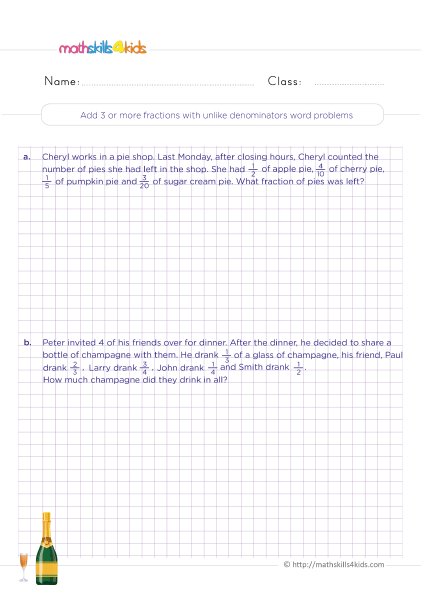 Print it...
Print it...
-
Add and subtract fractions with unlike denominators in recipes
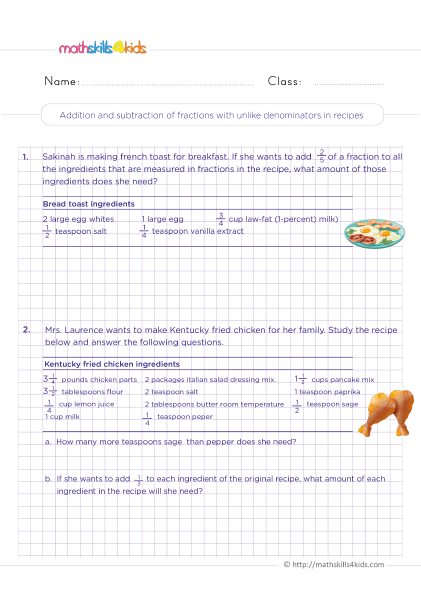 Print it...
Print it...
-
Identifying fractions with a particular sum denominators
-
Buying is supporting us!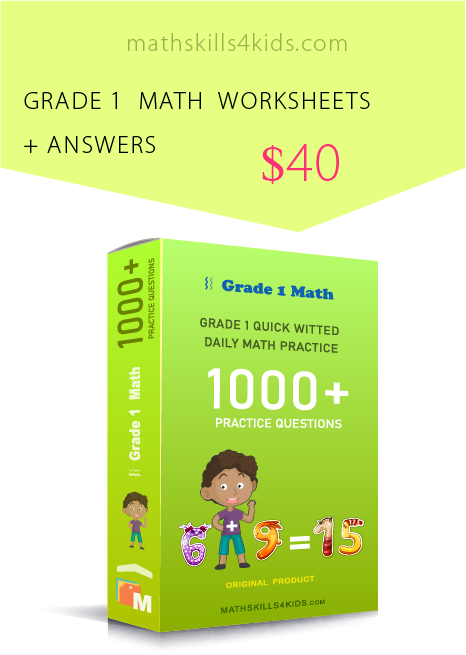
Buy Now...
-
-
Understanding the basics of adding and subtracting unlike fractions
Adding and subtracting fractions is a crucial skill that students must master to succeed in math. However, it can be challenging, especially when adding and subtracting unlike fractions. That is why understanding the basics of adding and subtracting unlike fractions entails mastering fractions, adding and subtracting fractions with like denominators, and finding a common denominator.
A fraction is a part of a whole. For example, if you have a pizza and cut it into eight equal slices, each slice is 1/8 of the pizza. Fractions have two parts: the numerator and the denominator. The numerator is the top number, and the denominator is the bottom number. The denominator tells you how many equal parts the whole is divided into, and the numerator tells you how many of those parts you have.
When adding or subtracting fractions with the same denominator, the process is straightforward. You add or subtract the numerators and keep the denominator the same. However, when adding or subtracting fractions with different denominators, the process is a bit more complex.
To add or subtract fractions with different denominators, first find a common denominator. To do this, you must find a number that both denominators can divide evenly. Once you have a common denominator, you can add or subtract the numerators and keep the denominator the same.
-
Common challenges faced by students in Grade 4 when adding and subtracting unlike fractions
Grade 4 is a critical year for students when it comes to math. It is the year they begin to learn more complex math concepts, such as adding and subtracting unlike fractions. However, this can be a challenging task for many students. One of the most common challenges students in grade 4 face when adding and subtracting unlike fractions, is finding a common denominator.
This can be a confusing process, especially when dealing with larger numbers. Students must understand the concept of a common denominator and how to find it to succeed in adding and subtracting unlike fractions.
Another challenge students in grade 4 face is understanding the concept of equivalent fractions. Students must first find a common denominator to add or subtract fractions with different denominators. To do this, they must understand the concept of equivalent fractions.
Equivalent fractions are two or more fractions that represent the same value. For example, 1/2 is equivalent to 2/4, equivalent to 4/8. Students in grade 4 must understand how to find equivalent fractions to succeed in adding and subtracting unlike fractions.
-
Importance of using Grade 4 adding and subtracting unlike fractions worksheets
Grade 4 adding and subtracting unlike fractions worksheets, are essential for students learning how to add and subtract fractions. These worksheets provide students with ample practice opportunities to master this essential skill.
They are designed to guide students through adding and subtracting fractions step by step, giving them the confidence they need to succeed.
Grade 4 adding and subtracting unlike fractions worksheets are an invaluable resource for parents and teachers alike, as they provide students with practice problems that reinforce the concepts they are learning in class.
Grade 4 adding and subtracting unlike fractions worksheets are essential because they provide students with practice opportunities tailored to their level of understanding. Most importantly, these worksheets are designed to build on the concepts that students have already learned, gradually increasing in difficulty as the student's understanding of the material improves. Also, this helps ensure that students stay calm and focused on the material, allowing them to build confidence in their mathematical abilities.
-
How MathSkills4Kids.com Grade 4 adding and subtracting unlike fractions worksheets, can help build confidence
At MathSkills4Kids.com, we understand the challenges students face when learning to add and subtract fractions. That's why we have created a series of Grade 4 adding and subtracting unlike fractions worksheets designed to help students go from confusion to confidence in math.
Our worksheets are designed to provide students with ample practice opportunities, guiding them through adding and subtracting fractions step by step. Our worksheets are also designed to be engaging and interactive, making learning more enjoyable for students.
Our adding and subtracting unlike fractions worksheets are tailored to each student's level of understanding, ensuring that they can handle the material. We also provide detailed answer keys, allowing students to check their work and identify areas where they may need additional practice.
Finally, by using our adding and subtracting unlike fractions worksheets, students can build their confidence in their mathematical abilities, which can positively impact their academic performance in other areas.
-
Types of worksheets available for Grade 4 adding and subtracting fractions
At MathSkills4Kids.com, we offer a variety of grade 4 adding and subtracting fractions with unlike denominators worksheets to meet the needs of every student. Our worksheets cover various topics, including finding a common denominator, adding and subtracting fractions with different denominators, and converting mixed numbers to improper fractions.
We also offer worksheets focusing on specific skills, such as reducing fractions to their lowest terms and finding equivalent fractions.
In addition to our grade 4 adding and subtracting unlike fractions worksheets, we also offer a range of other math resources to support grade 4 math learning. These resources include interactive games, videos, and quizzes that reinforce the concepts students are learning in class. Our resources are designed to be engaging and interactive, making learning more enjoyable for students.
-
Frequently asked questions about grade 4 adding and subtracting fractions with unlike denominators and their answers
1. What are like fractions?
Like fractions are fractions with the same denominator (the bottom number). For example, 2/5 and 3/5 are like fractions because they have 5 as the denominator.
2. What are unlike fractions?
Unlike fractions are fractions that have different denominators. For example, 2/5 and 3/4 are unlike fractions because they have different denominators (5 and 4).
3. Why must we find a common denominator when adding or subtracting fractions with unlike denominators?
We need to find a common denominator when adding or subtracting fractions with unlike denominators because we can only add or subtract fractions with the same denominator. This is because we can only compare or combine fractions with the same size of parts.
For example, we cannot add 1/2 and 3/4 directly because they have different denominators, meaning they have different parts sizes. We need to find a common denominator that both fractions can be converted to, to have the same size of parts. Then we can add or subtract them.
4. How do we find a common denominator for fractions with unlike denominators?
Different methods exist to find a common denominator for fractions with unlike denominators. One of the easiest ways is to use the least common multiple (LCM) of the two denominators. The LCM of two numbers is the smallest number that both can divide evenly.
For example, the LCM of 2 and 4 is 4 because 4 is the smallest number that both 2 and 4 can divide evenly. To find the LCM of two numbers, we can list their multiples and find the first one they have in common. For example, to find the LCM of 2 and 4, we can list their multiples:
Multiples of 2: 2, 4, 6, 8, 10,...
Multiples of 4: 4, 8, 12, 16,...
The first multiple they have in common is 4, so the LCM of 2 and 4 is 4.
Once we find the LCM of the two denominators, we can use it as the common denominator for both fractions. To do this, we need to multiply the numerator and denominator of each fraction by the same number, making the denominator equal to the LCM.
For example, to convert 1/2 and 3/4 to fractions with a common denominator of 4, we need to multiply both the numerator and denominator of each fraction by:
1/2 x (2/2) = (1 x 2) / (2 x 2) = 2/4
3/4 x (1/1) = (3 x 1) / (4 x 1) = 3/4
Now we have two fractions with a common denominator of 4: 2/4 and 3/4.
-
What are some tips and tricks for adding and subtracting unlike fractions effectively?
Several tips and tricks can help students confidently add and subtract fractions.
- One tip is always finding a common denominator before adding or subtracting fractions.
- Another tip is to simplify the fractions before adding or subtracting them. This can make the process easier and less confusing.
It is also important to double-check your work and make sure that you have simplified your answer.
Bonus: Additional resources for supporting grade 4 math learning
Do you want additional resources to spice your math lessons with fun and engaging activities? If so, you're in luck! We have compiled a list of some awesome resources that you can use to supplement your curriculum and make Grade 4 math learning fractions a breeze. Here they are:
- Math Playground: This website has many interactive games and videos covering various math topics, including fractions. You can find games that let your students practice adding and subtracting unlike fractions with visual models, word problems, and more.
For example, check out this game, Fraction Fling, where you will fling fractions onto a number line and match them with their equivalent forms. It's a great way to reinforce the concept of equivalent fractions and simplify fractions before adding or subtracting them. You can find this game and more at http://www.math-play.com/adding-and-subtracting-fractions-game.html.
- Khan Academy: This well-known online platform offers free lessons and exercises on various subjects, including math. You can find videos explaining how to add and subtract unlike fractions, step-by-step, and practice questions that give instant feedback and hints. You can also track your progress and earn badges as you learn.
For example, check out this video that shows you how to add fractions with the same denominator using fraction bars. It's a great way to visualize how fractions are added and why the denominator stays the same. You can find this video and more at https://www.khanacademy.org/math/arithmetic/x18ca194a:add-and-subtract-fractions-different-denominators.
- com: This website has a variety of printable worksheets and activities that you can use to reinforce adding and subtracting unlike fractions in your classroom. You can find worksheets with fraction problems with pictures, word problems, puzzles, coloring pages, and more.
For example, check out this worksheet with fraction problems with pizza slices. It's a great way to make fractions fun and relatable for your students. You can find this worksheet and more at https://www.education.com/worksheet/article/adding-and-subtracting-fractions-with-unlike-denominators/.
-
Thank you for sharing the links of MathSkills4Kids.com with your loved ones. Your choice is greatly appreciated.
Conclusion
Mathematics can be a challenging subject for many students, especially when it comes to fractions. However, with the right tools and resources, students can overcome their fear of fractions and gain confidence in their mathematical abilities.
Grade 4 adding and subtracting unlike fractions worksheets: free downloads are essential for students learning how to add and subtract fractions. They provide students with ample practice opportunities, guiding them through adding and subtracting fractions step by step. At Mathskills4kids.com, we offer a range of grade 4 adding and subtracting unlike fractions worksheets and other math resources to support grade 4 math learning.
We encourage parents and educators to utilize these resources to help their students build confidence and prepare them for more advanced math topics.
We hope you find these resources helpful and enjoyable for your students. With these resources, you can ensure they have a solid foundation and a positive attitude toward math.
Happy learning!
